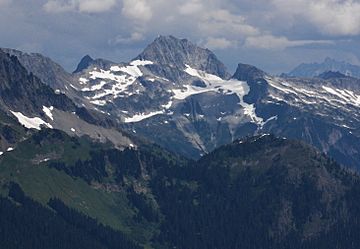Hurry-up Peak facts for kids
Quick facts for kids Hurry-up Peak |
|
|---|---|

Hurry-up Peak seen from the northwest from Hidden Lake Peaks
|
|
| Highest point | |
| Elevation | 7,821 ft (2,384 m) |
| Prominence | 1,061 ft (323 m) |
| Isolation | 1.61 mi (2.59 km) |
| Parent peak | Spider Mountain (8,286 ft) |
| Geography | |
| Location | Washington, U.S. |
| Parent range | North Cascades |
| Topo map | USGS Cascade Pass |
| Type of rock | Gneiss |
| Climbing | |
| Easiest route | class 3 scrambling via Ptarmigan Traverse |
Hurry-up Peak is a tall mountain peak in Washington state. It stands 7,821 feet (about 2,384 meters) high. You can find it where Skagit County and Chelan County meet.
This peak is part of the North Cascades mountain range. It's also at the northern end of a famous hiking route called the Ptarmigan Traverse. Hurry-up Peak is located near Cascade Pass. It sits right on the edge of North Cascades National Park and the Glacier Peak Wilderness.
Other mountains nearby include Spider Mountain to the south, Magic Mountain to the north, and Trapper Mountain to the east. Sometimes, Hurry-up Peak is also called Ess Mountain or S Mountain.
A glacier called the S Glacier is on the eastern side of the peak. Water from this melting glacier flows into Trapper Lake. Rain and snowmelt on the east side of the mountain flow into the Stehekin River. On the west side, water drains into the Cascade River.
Contents
What's the Weather Like on Hurry-up Peak?
Hurry-up Peak is in a marine west coast climate zone. This means it gets a lot of moisture from the Pacific Ocean. Most of the weather systems start over the Pacific. They then travel northeast towards the Cascade Mountains.
How Mountains Affect Weather
When these weather systems reach the North Cascades, the tall peaks force the air upwards. This process is called Orographic lift. As the air rises, it cools down. This causes the moisture in the air to turn into rain or snowfall.
Because of this, the western side of the North Cascades gets a lot of precipitation. This is especially true in winter, when there's heavy snowfall.
Seasonal Weather Patterns
During the winter, the weather is usually cloudy. However, in the summer, high-pressure systems often form over the Pacific Ocean. These systems bring clear skies and less cloud cover.
The influence of the ocean means that the snow tends to be wet and heavy. This can lead to a high risk of avalanches, which are dangerous slides of snow down the mountain.
How Hurry-up Peak Was Formed
The North Cascades mountains are known for their very rugged and dramatic landscape. They have jagged peaks, sharp ridges, deep valleys carved by glaciers, and tall, pointy granite rocks.
Ancient Geological Events
Many millions of years ago, huge geological events shaped this area. These events created the varied landscape and the big changes in elevation you see today. These elevation changes also lead to different climates and types of plants in the area.
The Cascade Range began to form millions of years ago, during the late Eocene Epoch. At that time, the North American Plate (a huge piece of Earth's crust) was slowly moving over the Pacific Plate. This movement caused many volcanic eruptions.
Building the North Cascades
Around 50 million years ago, smaller pieces of Earth's crust, called terranes, crashed into the North American continent. These collisions helped build the North Cascades mountains.
During the Pleistocene period, which started over two million years ago, glaciation played a big role. Huge sheets of ice (glaciers) moved across the land many times. As they advanced and retreated, they scraped away rock and left behind debris. The "U"-shaped valleys you see in the mountains today were carved out by these ancient glaciers.
The Final Touches
The main forces that created the tall peaks and deep valleys of the North Cascades were uplift (when land is pushed up) and faulting (when cracks form in the Earth's crust). These processes, combined with the power of glaciers, shaped the mountains into what they are today.



